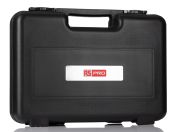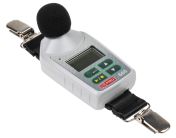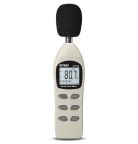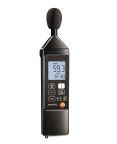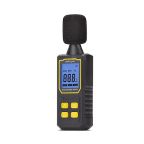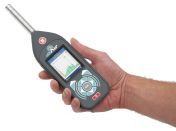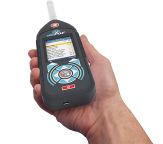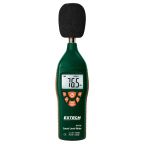Sound Level Meters
Sound level meters, also known as decibel meters or noise meters, are handheld electronic devices used to measure the noise level in a given environment. These readers measure sound pressure levels (SPL), typically expressed in decibels (dB). They are designed to capture acoustic measurements, providing data on the intensity of sound.
Most sound level meters feature an integrated digital display for easy reading in decibels, while some have an inbuilt datalogging memory to store readings. Additionally, many professional models can be attached to a smartphone or tablet, allowing for seamless data sharing. Certain models also allow connecting to a computer for exporting data.
Benefits of Sound Level Meters
Sound level meters provide accurate measurements of noise levels in an environment. High noise exposure can lead to hearing damage, loss, and other health issues. By using a sound meter, you can assess the noise levels and take appropriate action, such as adjusting machinery speed to reduce excessive noise or ensuring the use of proper Personal Protective Equipment (PPE) to minimise health risks.
Sound level meters also play a key role in maintaining a healthy building by improving noise control.
Accuracy Classes of Sound Level Meters
There are two classes of sound meter; Class 1 and Class 2 (also referred to as Type 1 or Type 2).
Class 1
Class 1 sound level meters are built for high-precision measurements and offer the highest level of accuracy. These meters adhere to strict international standards and are designed for professional, scientific, and regulatory use. Their exceptional accuracy makes them ideal for tasks that require precise noise and volume measurements, such as environmental monitoring, research, and compliance with noise regulations. Class 1 meters are often used in laboratories, noise studies, and where reliability and fine detail are crucial.
Class 2
Class 2 sound level meters are more affordable and provide a good level of accuracy for general-purpose use. While they are not as precise as Class 1 meters, they are still reliable for routine measurements and are widely used in situations where ultra-high accuracy is not essential. These meters are commonly used for everyday noise assessments, such as workplace noise monitoring, construction site evaluations, and personal sound level checks.
Frequency Weighting
Weighting refers to the frequency range that is measured. Some sound meter devices will only measure one frequency range, while other models are able to measure all.
A-Weighting (dBA)
A-Weighting is designed to mimic the human ear's sensitivity to sound, emphasising frequencies between 20 Hz and 20 kHz while reducing the impact of lower and higher frequencies. It's ideal for measuring general environmental noise and occupational exposure.
C-Weighting (dBC)
C-weighting is used to measure high-level noise sources above 100 decibels (dB). It provides a flatter frequency response than A-weighting, making meters with this weighting suitable for assessing peak sound levels and the potential for hearing damage in environments with loud voices or noise.
Z-Weighting
Z-weighting, or unweighted measurement, captures the full frequency spectrum from 10 Hz to 20 kHz, providing an accurate and comprehensive sound profile with minimal attenuation. It’s used for detailed acoustic analysis.
Why Is Calibration Important?
Calibration ensures that your sound level meter provides accurate and reliable measurements, maintaining optimal performance over time. Regular calibration is essential for meeting industry standards and achieving precise results.
- Ensures Accuracy: Calibration ensures your noise meter consistently delivers precise readings, reducing the risk of errors or discrepancies in measurement data and ensuring reliable results for any application.
- Maintains Compliance: Regular calibration helps meet regulatory and industry standards, ensuring your measurements are valid for legal, safety, and environmental compliance purposes.
- Increases Instrument Lifespan: Calibration helps identify any issues with the sound level meter early on, preventing wear or malfunction, ultimately extending the device’s lifespan and ensuring consistent performance over time.
- Boosts Confidence in Measurements: Knowing your instrument is properly calibrated instils confidence in the accuracy of the data collected, which is especially important for critical assessments or when making important decisions based on measurements.
- Prevents Costly Mistakes: Accurate measurements reduce the chance of making costly mistakes due to inaccurate data, which can have significant financial, safety, and regulatory implications.
Dosimeter vs. Sound Level Meter
A dosimeter is a small, portable device worn by individuals to measure their personal exposure to noise over time. It provides a cumulative reading of noise levels throughout a workday. In contrast, a sound level meter is a handheld device used to measure and record sound levels in a specific environment at a given moment. While dosimeters track long-term exposure, sound level meters capture instantaneous sound levels in various settings.
Common Sound Level Meters Applications
- Environmental Noise Measurement: Sound level meters are used to assess noise pollution levels in urban areas or near industrial sites, ensuring compliance with regulations.
- Workplace Safety: These detectors monitor noise levels in factories, construction sites, and offices, ensuring workplace safety.
- Product Testing: Evaluates noise emissions from products such as machinery, vehicles, or appliances to meet industry standards.
- Construction Site Monitoring: These meters measure noise levels at construction sites to ensure they comply with local environmental and safety guidelines.
- Regulatory Compliance: Used by local authorities to ensure that industrial and residential areas comply with noise control regulations.
How to Choose the Right Sound Level Meter?
When selecting a sound level meter, consider factors such as accuracy class (Class 1 or Class 2), measurement range, and frequency weighting (A, C, or Z). Evaluate the display type (digital or analogue) and additional features like data logging capabilities or connectivity options for ease of data sharing. Ensure the meter is calibrated for precise measurements and is suitable for the specific environmental conditions where it will be used.
How to Order Sound Level Meters from RS Hong Kong?
RS Hong Kong is a trusted supplier of sound level meters from renowned brands such as Castle, Extech, and FLIR. You can conveniently order online, with options for quick delivery or collection at your local branch. Alternatively, you can call us at 852 2421 9898 for assistance. Additionally, we offer blanket orders, which allow you to set a spending limit for multiple purchases under a single order number.
How Delivery Works at RS Hong Kong?
RS Hong Kong offers same-day delivery for online orders of sound level or decibel meters placed before noon, Monday to Friday, and next-day delivery is available for orders placed in the afternoon on weekdays. Our fast delivery options ensure you receive your products quickly when needed. For more information on delivery details and options, please refer to our delivery page.
